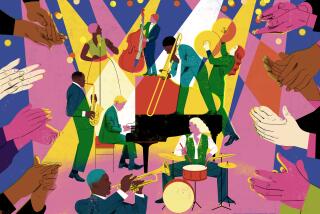Quartet Captures Gillespie’s Innovative Spirit in ‘Dizzy’
- Share via
“Dizzy: The Man and the Music” seems an awfully ambitious title for a show of little more than an hour, performed by only four musicians. After all, volumes have been written on the impact of trumpeter, composer and bandleader John Birks “Dizzy” Gillespie, who died four years ago this month.
But the quartet that opened a two-night stand at the Orange County Performing Arts Center’s Founders’ Hall “Jazz Club” Friday created a strong sense of the late bebop innovator’s spirit, with only a half-dozen selections.
Led by bassist and longtime Gillespie associate John Lee, the group played smartly and with purpose while imparting the sense of fun and humor that Gillespie brought to the bandstand each time he played.
A large measure of this spirit came from trumpeter and Gillespie protege Jon Faddis, who introduced the tunes, took a few comic, playful turns (at one point, he serenaded a drowsy child in the audience with an impromptu lullaby) and played with Gillespie’s trademark sense of drama.
Faddis has assimilated much of the honoree’s style: His play was marked by long, slightly smeared, Gillespie-like phrases and sudden, attention-grabbing shifts of pitch and volume.
Faddis’ strong performance was matched by pianist Cyrus Chestnut, whose lyrical solo during “Birks’ Works” contrasted nicely with Faddis’ more frantic play. The two were of a single mind on Thelonious Monk’s “ ‘Round Midnight” as Chestnut echoed a series of muted trumpet coos with his own spare, highly polished lament.
Lee’s use of electric bass helped the group avoid a retro sound. Indeed, his solos--sprinkled with double stops, thumb funk and ringing, upper register tones--often gave the tunes a decidedly modern feel. Cuban-born drummer Ignacio Berroa, a mainstay of Gillespie’s United Nations Orchestra, also added contemporary spice, especially on Afro-Cuban numbers he propelled with polyrhythmic accents and galloping tom-tom passages.
It’s doubtful that this program would have worked as well in the arts center’s 3,000 seat Segerstrom Hall. The intimacy of the 230-seat Founders’ Hall allowed Faddis and company to get up close and personal with the audience, as Gillespie himself always managed to do.
More to Read
The biggest entertainment stories
Get our big stories about Hollywood, film, television, music, arts, culture and more right in your inbox as soon as they publish.
You may occasionally receive promotional content from the Los Angeles Times.









